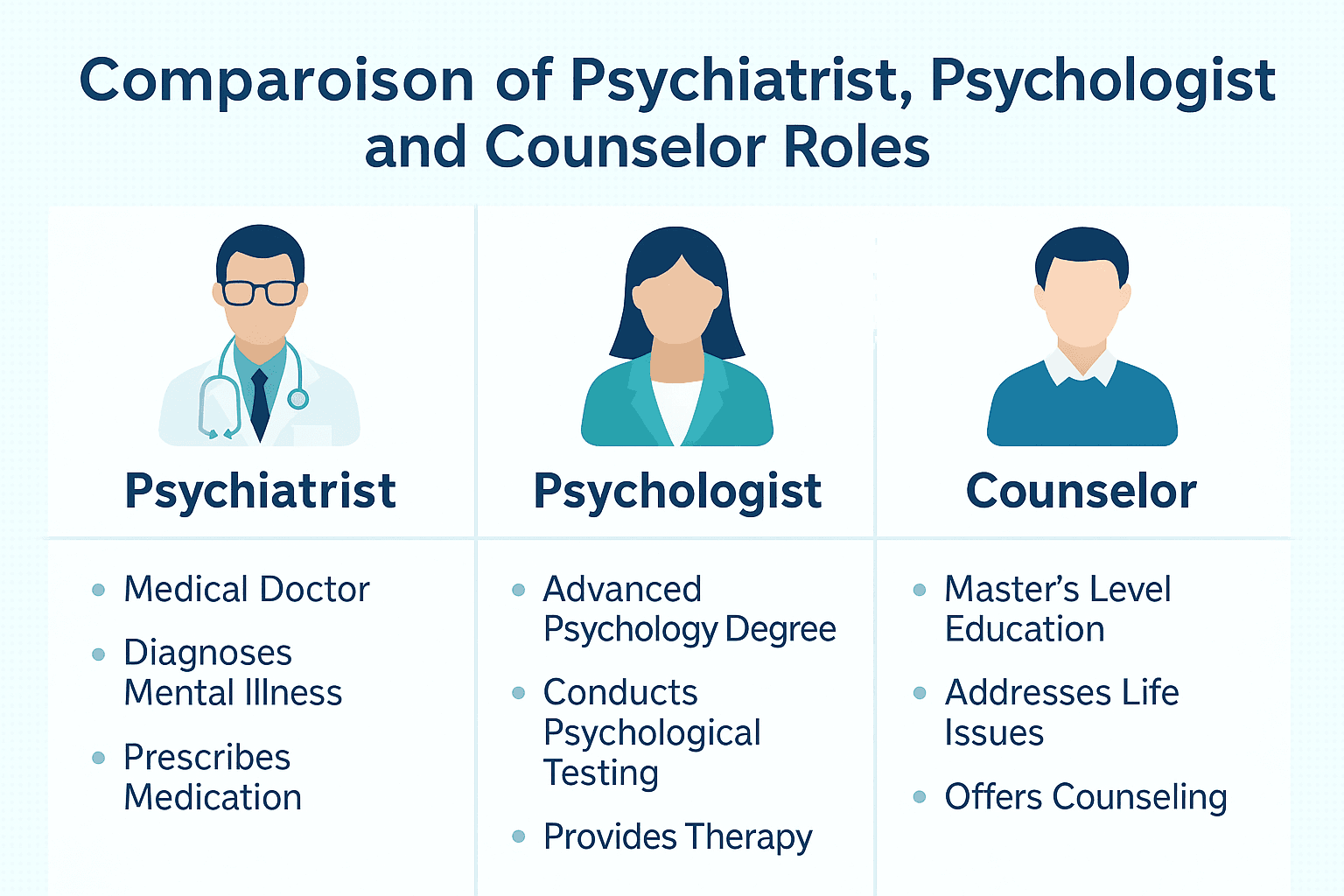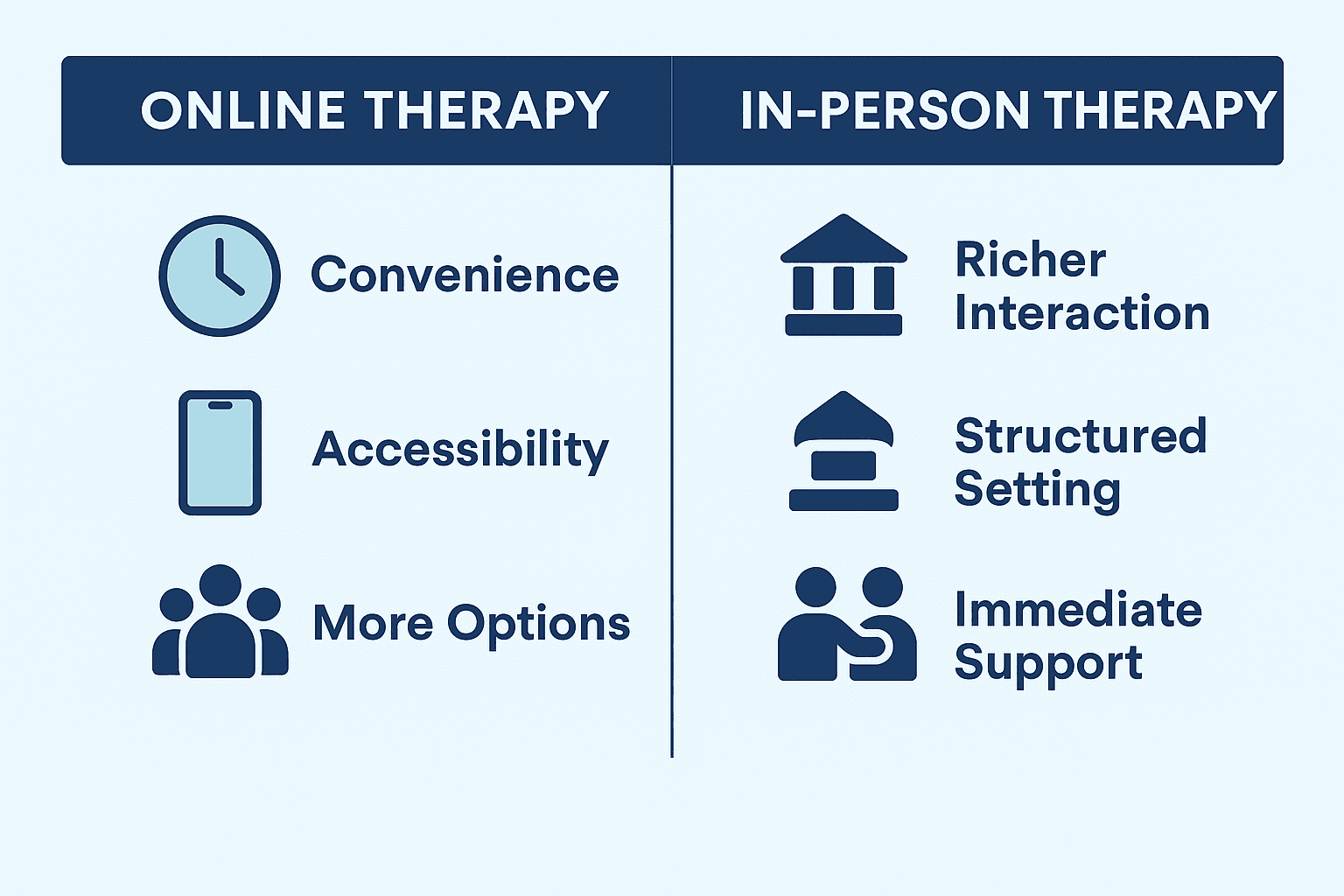Introduction
How to choose the right therapist in 2025 can feel overwhelming. You may be wondering: Do I need a psychiatrist, a psychologist, or a counselor? Will my insurance cover the sessions? Should I go online or meet in person?
With mental health awareness at an all-time high, more people are seeking therapy — but navigating the options is not always easy. Whether you’re in the U.S. (with parity laws expanding access) or in India (where mental health coverage is growing under IRDAI’s mandate), the choices can leave you confused.
This guide is here to simplify the process for you. We’ll walk through therapist types, how to match one with your needs, how insurance affects your choice, red flags to avoid, and tips for building a strong relationship once you start therapy.
Why Choosing the Right Therapist Matters
A therapist isn’t just another medical professional. The connection you build is personal, emotional, and transformative. Studies show that the therapeutic alliance (the trust and bond between you and your therapist) is one of the biggest predictors of successful outcomes — sometimes more important than the therapy style itself.
👉 Example: A 29-year-old software engineer in California tried three different therapists before finding someone who matched her cultural background and communication style. Once the fit was right, her progress accelerated within months.
Understanding Therapist Types in 2025

Psychiatrists (MDs/DOs)
Medical doctors specializing in mental health.
Can prescribe medications (antidepressants, antipsychotics, etc.).
Often handle complex cases (bipolar disorder, schizophrenia).
Psychologists (PhD/PsyD)
Provide therapy (CBT, DBT, EMDR).
Trained in assessments and evidence-based interventions.
Cannot prescribe in most regions (exceptions in some U.S. states).
Licensed Counselors & Therapists
Masters-level professionals (LPC, LMFT, LCSW).
Provide talk therapy for anxiety, depression, trauma, relationships.
Often more accessible and affordable than psychiatrists.
Peer Support and Coaches
Growing trend in 2025.
Non-clinical, focus on guidance, motivation, and coping skills.
Not insurance-covered in most cases.
What to Ask Before Choosing a Therapist
1. What’s your specialization? (Anxiety, trauma, couples therapy, etc.)
2. What therapy methods do you use? (CBT, psychodynamic, mindfulness).
3. How do you measure progress? (Journals, surveys, feedback tools).
4. Do you offer virtual sessions?
5. What are your fees, and do you accept my insurance ?
💡 Tip: Many therapists in 2025 offer free 15-minute consultations. Use that call to sense whether you feel comfortable.
Checking Insurance Coverage
In the U.S.
Thanks to parity laws, most employer and marketplace plans must cover therapy the same way they cover medical care.
Medicare now covers intensive outpatient programs and telehealth mental health sessions through 2025.
Use your insurer’s provider directory to find in-network therapists.
👉 External Link: Mental Health Coverage – NAMI
In India
IRDAI mandates coverage for mental illness under the Mental Healthcare Act (2017).
Most plans cover inpatient psychiatric treatment (hospital stays).
Outpatient therapy (OPD) often requires special riders or employer wellness benefits.
👉 External Link: IRDAI Guidelines on Mental Health Insurance
Internal Resource
See our guide: Understanding Your Insurance to decode your policy’s mental health section.
Virtual vs. In-Person Therapy in 2025

Benefits of Virtual Therapy
Convenient from home.
Covered at parity with in-person in the U.S.
India: many insurers now tie up with telehealth platforms for OPD coverage.
Benefits of In-Person Therapy
Stronger personal connection.
Suitable for severe conditions or group therapy.
💡 Hybrid models (mixing online + in-person) are trending in 2025.
Red Flags to Watch Out For
Not every therapist is a good fit. Watch for:
Guarantees of “quick cures.”
Lack of clear boundaries.
No structured plan or progress check.
Poor communication or unprofessional behavior.
Building a Strong Therapist–Patient Relationship
Be open and honest.
Set clear goals (e.g., reduce panic attacks, improve relationships).
Ask for feedback — and give feedback too.
Reassess fit after 4–6 sessions.
👉 Internal Link: Mental Health Insurance Coverage 2025 for tips on how expanded coverage can support therapy.
Global Behavioral Health Trends Shaping Therapy
- Measurement-based care: Therapists track your progress with surveys and digital tools.
- Condition-specific care: Programs for postpartum depression, PTSD, or substance use.
- AI-assisted therapy tools: Chatbots and apps supplement human therapy.
- Employer support: Workplace mental health benefits are expanding worldwide.
Key Takeaways for You and Your Family
- Start with your needs (anxiety, trauma, stress) before picking a therapist type.
- Check insurance coverage — it can save you thousands.
- Use free consultations to test the fit.
- Watch for red flags.
Remember: therapy is a journey, not a quick fix.
FAQs – How to Choose the Right Therapist in 2025
How do I know which therapist is right for me?
Look for someone who specializes in your issue and makes you feel comfortable after the first few sessions.
Does insurance cover therapy?
In the U.S., yes under parity laws. In India, mostly inpatient unless you buy riders.
Should I choose online or in-person therapy?
Both work — online is more convenient, in-person may build stronger connections. Hybrid is ideal.
How many sessions before I know if it’s working?
Usually 4–6 sessions give you a sense of progress and fit.
What if I can’t afford therapy?
Try in-network providers, EAP programs from employers, or community clinics. In India, some NGOs offer low-cost counseling.

